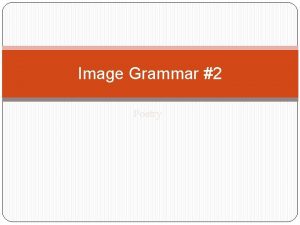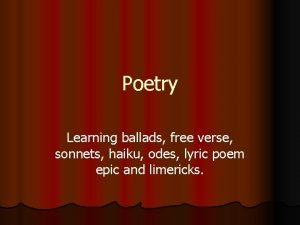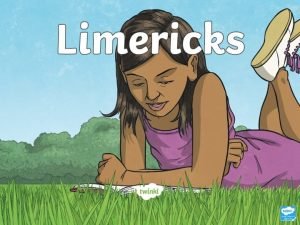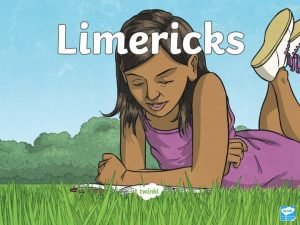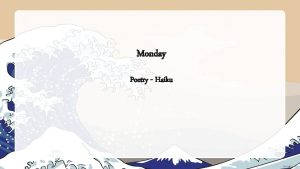Limerick and Haiku Poetry Limericks A limerick is








- Slides: 8

Limerick and Haiku Poetry

Limericks • A limerick is a five-line poem written with one couplet and one triplet. • A couplet is a two-line rhymed poem. • A triplet is a three-line rhymed poem. • The rhyme pattern is a a b b a with lines 1, 2 and 5 containing three beats and rhyming, and lines 3 and 4 having two beats and rhyming. • Some people say that the limerick was invented by soldiers returning from France to the Irish town of Limerick in the 1700's.

Practice with Limericks A flea and a fly in a flue Were caught, so what could they do? Said the fly, "Let us flee. " "Let us fly, " said the flea. So they flew through a flaw in the flue. • How many beats are in each line (1, 2, and 5 should have three beats; 2 and 4 should have two beats)? • Does this limerick follow the a a b b a pattern?

Practice with Limericks Try completing this limerick. There once was a pauper named Meg Who accidentally broke her _______. She slipped on the ______. Not once, but thrice. Take no pity on her, I ____.

Create your Own! • Work in groups to create your own limerick. • Use the a a b b a 5 -line form to create your poem. • Practice the rhythm of limericks by clapping you hands or snapping your fingers.

Haiku • Haiku poems are generally written to describe nature. • The most widely recognized form consists of a threeline stanza that has a total of 17 syllables, written in the following pattern: Line 1: 5 syllables Line 2: 7 syllables Line 3: 5 syllables Clouds float slowly by Fluffy, lumpy, cotton balls Silver, gray, and white • The words and phrases used in haiku do not rhyme.

Practice with Haiku • When writing a haiku, the author's purpose is to transform a seemingly common nature-related topic into something special or extraordinary by using words. Bursting in bright hues Splashing colors all about Autumn leaves must fall • How many syllables are there in each line of this poem? • What is the subject (topic) of this poem? • What interesting and descriptive words to you see in this poem?

Create your Own! • The first step in writing a haiku poem is to choose a good topic. Haiku poems are generally written about nature. • Let’s brainstorm a list of nature-related topics. Subjects might include: different types of weather, clouds, landforms, water formations, seasons, etc. • Brainstorm words or phrases that describe the topic. • Put the words and phrases together to describe the topic in three lines according to the 5 -7 -5 syllable pattern. • Work in groups to create your own haiku.



